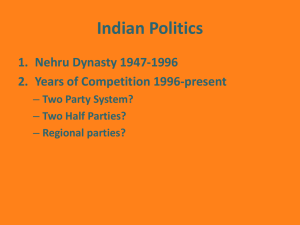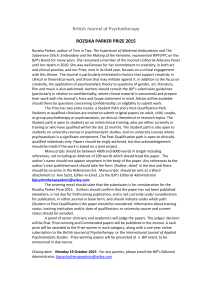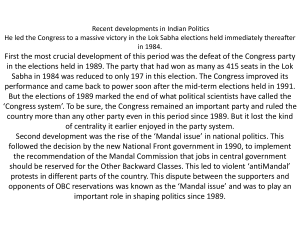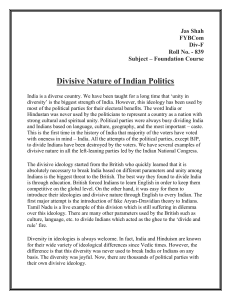India*s Democracy
advertisement
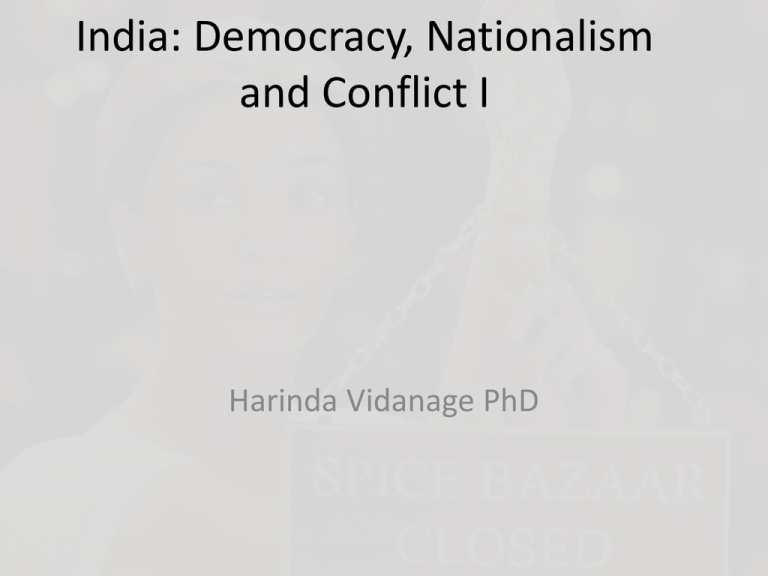
India: Democracy, Nationalism and Conflict I Harinda Vidanage PhD • India’s relative success in comparison the Pakistan and Nepal • Long history of nationalist struggle • Coherent political party • Regional and central political leadership committed to liberal democracy • Distribution of political and economic power Key advantage in the congress party • • • • Virtual monopoly of power Its model of interlocking governance Accommodation of India’s diversity It included diverging ideologies, socialists and capitalists happily coexisted • Extreme right and left Hindu fundamentalism and radical communisim was brutalluy dealt with: Ex militant RSS was banned by 1950 • The party nationalist symbols and rhetoric's converged its power and yet was able to accommodate particularistic agenda of its ethnic and religious parts • In the first two decades since independence opposition to the leadership of the congress came within the congress. • India’s founding leaders believed that a strong central government with powers over the economy and politics was necessary to build a stable country Mahatma’s Gandhi’s favoured disciple and chosen successor. Son of Motilal Nehru, one of the founder figures of the Congress movement. A brilliant intellectual and gifted speaker, his Autobiography (1930) had a profound impact on educated Indians who saw him as the spokesman for the new India. After death of Gandi(1948) and Vallabhai Patel (1950) he became the founding father of the nation, known by the Brahmin name of Panditji “Teacher, a symbol of affection and respect. Nehru was hugely popular with the masses and first three Elections of1953, 1957 & 1962 were massive endorsements for Nehru & Congress, giving him more economic, social and political power than almost any British Viceroy before him. Republic of India. 1950. New Constitution based on British Parliamentary Model. President: Formal Head of State Prime Minister: Real Leader of Republic Headed Majority Party in Indian Parliament. Indian Legislature http://www.parliamentofindia.nic.in/ Rajya Saba/Council of States 250 Lok Sabha/House of People Max 552 Political elites Sir Isaiah Berlin. "Nehru was a great man... Nehru gave to Indians an image of themselves that I don't think others might have succeeded in doing” Central Planning In keeping with the prevailing theories in development planning after World War II, in the 1950s India opted for a centrally planned economy with a closed trade regime, heavy state intervention, and an industrial policy that emphasized import substitution. This pro-state and trade-pessimistic development model was characterized by three sets of controls: internal, external, and those relating to the special role of the public sector • In the first two decades since independence India faced external military threats from China and Pakistan. No internal challenge to Premier Nehru in Parliament • • • • • 1948 1962 1965 1971 1999 Major religions • Hindus 82.00%, Muslims12.12% Christians 2.34% Sikhs1.94% Other religions less than 1% 1984.Siege of Golden Temple. “Let them come, we will give them battle” Snapshot (Uttar Pradesh) • February 2012 • Voters 126 Million • Not dominated by Congress or BJP • Voting for 403 state assembly constituencies in the northern state, with a population of 200 million, is spread over seven phases and will last until March 3. Congress in decline • Congress government under PM Narasimha Rao implemented open policies of economic liberalization • Manmohan Singh introduces the first liberal budget • Denationalization of state institutions • 1992 Ayodhya incident and communal violence • Congress turns to the middle class elite from the poor • Political corruption • 1996 Rao resigns, Sonia refuses leadership , Congress defeated by the BJP in the general elections, UF government and 1998 BJP back to power BJP regime 1998 BJP: The BJP is the successor party of the BJS, which merged itself into the Janata Party in 1977. The BJP was formed as a separate party in 1980 after internal differences in the Janata Party resulted in the collapse of it's government in 1979. ‘During the six decades of our independence, governance of our country, except for a short period, was with the Congress and its associates. It was most unfortunate that they never thought of creating a socio-economic and political paradigm of governance drawing from the civilizational consciousness of India. They, instead, tried to emulate whatever was being practised in this or that Western country. The disastrous results are before us.’ ( 2009 Election Manifesto) Competing nationalisms (communalism) • Hindu and Muslim revivalism in late 19th century • Arya Samaj/ Brahmo Samaj –based on monolithic concepts of Hindu values and superiority over other religions • Creation of RSS (Rashtra Swayamsevak Sangh) a powerful Hindu fundamentalist political organization • Aligarch movement emancipation of Muslims • Issue of cow protection Communalisms in the late 20 Century • Congress party failings in multiple spheres • Hindu radicalism seen as a national alternative political force • Rise of the BJP • ‘Over the last eight years, two entwined and co-constitutive global trends have been present in the Indian context. One is the unfolding tension of a ‘war on terror’, while the other refers to a more long-standing socio-economic and political marginalization of Muslims’ (Kinnvall and Swensson 2010) 9/11 connection • The Indian Prime Minister, Atal Bihari Vajpayee (BJP), in a televised address on 14 September 2001, linked India to the global fight: • ‘My dear countrymen, as you know, terrorists have struck yet another blow – at the United States of America, at humanity, at the civilized way of life. . . . Every Indian has to be a part of this global war on terrorism. We must, and we will, stamp out this evil from our land, and from the world. Jai Hind [Victory to India]. 1990-1992. Nationwide Campaign Spearheaded by BJP for demolition of “Babri Masjid,” Ayodhaya 1992 Hindu-Muslim Riots. 2,000 Dead Rise of BJP. 1990 - 1998. BJP record • • • • 1984. 7% of Vote. 2 Seats in Lok Sabha 1991. 20% of Vote.119 Seats 1996. 20.9 % of Vote.161 out of 543 seats. Largest party in Lok Sabha. With help of its allies achieved combined total of 194 seats and formed short lived government • 1998. 25.59% of Vote.182 seats • 1999 273 seats and in power till 2004 • Defeated comprehensively in 2009 general election • Holds power in ten states in India Prelude to Mr and Mrs Iyer Backdrop of violence, Hindu extremists massacre thousands of Muslims in response to Muslim mob attack on one of the cars of a train carrying Hindu nationalist activists (Vishva Hindu Parshad/ VHP) that had stopped in Godhra, a town near the Gujarati capital of Ahmedabad, was set on fire, incinerating more than 50 passengers in February 2002 Democracy and corruption • Anna Hazare: Anti corruption Activist http://www.pbs.org/newshour/rundown/2011 /12/anna-hazare.html

